<!--[if
!supportEmptyParas]-->I have been seeking a specimen of the real
Anthurium hookeri for years! Before you immediately respond and
say yes, please look at the photos and read the descriptions in this
thread. The majority of plants sold in Florida are not the
true species known to science as Anthurium hookeri. but instead a
plant using the name as a common name. This plant appears to be far rarer than
many of us believe. It is found largely in the windward islands of the
Caribbean but also in French Guiana and other countries including
Venezuela. I've talked several times to Joep Moonen in French Guiana
about it and he sees it rarely.
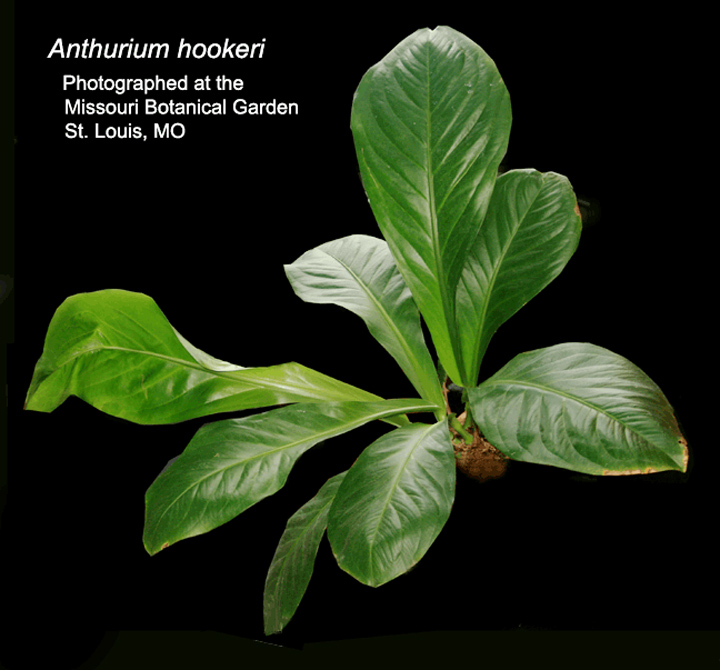
<!--[if
!supportEmptyParas]--> <!--[endif]-->
Few people appear to be
able to give a good reason why almost everyone in Florida thinks they are
growing Anthurium hookeri in their yard when they are not. Well known
IAS member and commercial aroid grower Denis Rotolante in Homestead offered
the best reason I have been able to find, "As many nurserymen down here
know, Anthurium hookeri is a catch all name applied to all bird nest type
Anthuriums regardless of true taxonomic origins." Many of those
hybrid plants sold in Florida appear to be more closely related to
Anthurium schlechtendalii or Anthurium plowmanii than to
Anthurium hookeri.
<!--[if
!supportEmptyParas]--> <!--[endif]-->
If you
believe you are growing Anthurium hookeri and your plant matches the
photos and information in this thread I know for certain there are other
growers that want to find it, including me!
<!--[if
!supportEmptyParas]--> <!--[endif]-->
The first
two photo shows a specimen of the true Anthurium hookeri photographed
at the Missouri botanical Garden. Look closely at the leaves and
veins.
<!--[if
!supportEmptyParas]--> <!--[endif]-->
<!--[if
!supportEmptyParas]--> 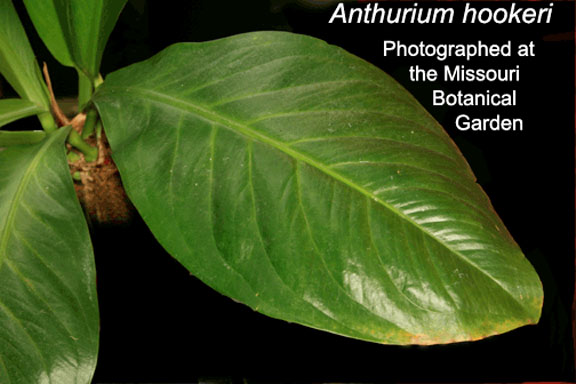 <!--[endif]-->
<!--[endif]-->
<!--[if
!supportEmptyParas]--> <!--[endif]-->
One of the
most distinctive characteristics of the true Anthurium hookeri is it does not
produce red berries as is commonly believed on the internet and many plant
forums. The berries of the true species are white.
Virtually
all the information on the Internet stating the berries are red is inaccurate.
I even found one noted garden showing a photo of an infructescence with red
berries. The plant referred to in all the garden site posts appears to
be one of the common plants sold in Florida using the name only as a common
name and not referring to the true species..
<!--[if
!supportEmptyParas]--> <!--[endif]-->
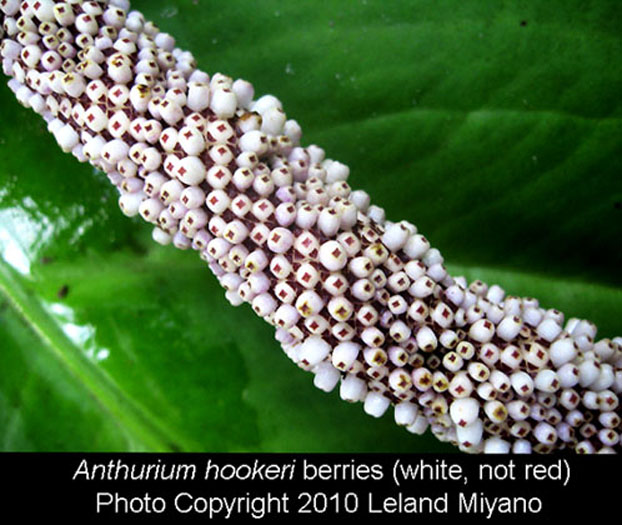
The next
distinctive characteristic of Anthurium hookeri is the interprimary
veins are evenly spaced similar to the rungs of a ladder.
In science this even spacing is known as the venation being
scalariforme.

Another important
characteristic is a newly emerging leaf unfurls in a way that is not seen in
other bird’s nest Anthurium species. The unusual way
the new leaves of Anthurium hookeri are rolled is known as being
supervolute vernation
and are very unusual in most species. That term indicates
the new leaves possess coils or folds in overlapping whorls.
Vernation refers to the arrangement of young leaf blades and
supervolute vernation is to possess a convolute arrangement in the folding or
arrangement of a newly emerging leaf blade with one margin (edge) of the newly
blade emerging rolled inward toward the midrib and the opposite margin rolled
around the midrib o the opposite leaf f in a manner similar to the coil at the
end of a conch shell.
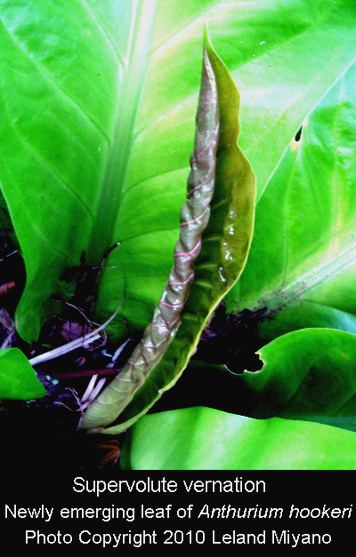
All bird’s nest
Anthurium, at least those that are members of Anthurium section
Pachyneurium, produce convolute new leaves. The only
difference in supervolute and convolute vernation is convolute vernation
occurs when several leaves spiral with the next leaf in a module enclosed
within the current leaf. I realize this is difficult to understand but look at
the leaf in the photo as well as the diagram below. Look closely at the
diagram of convolute vernation and you will see the second leaf inside the
first leaf which is common to the way bird's nest forms unfurl.
Anthurium hookeri is the only exception according to Dr. Croat.
Tom once indicated he felt Anthurium hookeri could be in section
Porphyrochitonium.
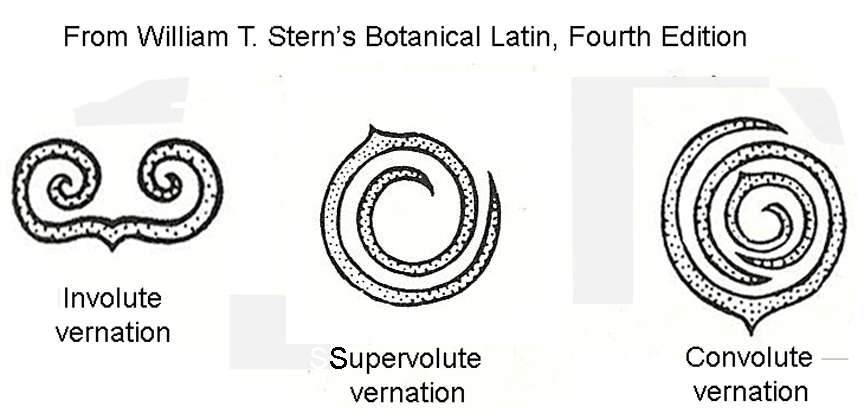
<!--[if
!supportEmptyParas]--> <!--[endif]-->
Another very important
characteristic is the real Anthurium hookeri has tiny black dots,
especially on the underside of the leaves. In science these little black dots
are known as glandular punctates.

<!--[if
!supportEmptyParas]--> <!--[endif]-->
If you have real species of
Anthurium hookeri please post photos and if you know where specimens of
your plant can be found please post that as well.
There are several other
unique characteristics found only on Anthurium hookeri and not on the
hybrid or miss named plants commonly sold in Florida. If you want to learn
more the information can be read here: http://www.exoticrainforest.com/Anthurium%20hookeri%20pc.html
The scientific description
of Anthurium hookeri is very simple; so for anyone that may doubt the
accuracy of what I am trying to explain please take a few seconds to read the
actual description.
A. hookeri Kunth, Enum. pl. 3:74.
1841. Type: Schott Drawing 517 serves as the lectotype (designated by
Mayo, 1982)
Epiphyte. Internodes short
densely rooted; cataphylls lanceolate, 20-26 cm long, dilacerating from
base. VERNATION- supervolute; Leaves rosulate;
petioles triangular to D-shaped, 2-9 cm long, 1.5-1.7 cm wide; blades
oblanceolate, broadest above middle, margins smooth, black glandular punctates
on both surfaces, 35-89 cm long, 10-26 cm wide. Primary lateral
veins 9-15 per side, free to the margin, tertiary veins extending in a
more or less parallel, ladder-like fashion between the primary lateral veins
(scalariform). peduncle to 47 cm long, to 5 mm dam.; spathe pale green,
tinged purple, oblong, to 9 cm long, to 1.5 cm wide; spadix violet-purple,
cylindroid-tapered, to 10-16 cm long, to 5-7 mm diam,; Infructescence-
berries, obovoid, whitish, to 6 mm long, to 4.5 mm wide.
<!--[if
!supportEmptyParas]-->
<!--[endif]-->
I really want to find this
plant so thanks very much for any help!
Steve
www.ExoticRainforest.com
<!--[if
!supportEmptyParas]--> <!--[endif]-->
<!--[if
!supportEmptyParas]--> <!--[endif]-->
<!--[if
!supportEmptyParas]--> <!--[endif]-->
<!--[if
!supportEmptyParas]--> <!--[endif]-->
<!--[if
!supportEmptyParas]--> <!--[endif]-->
<!--[if
!supportEmptyParas]--> <!--[endif]-->
<!--[if
!supportEmptyParas]--> <!--[endif]-->
<!--[if
!supportEmptyParas]--> <!--[endif]-->
<!--[if
!supportEmptyParas]--> <!--[endif]-->
<!--[if
!supportEmptyParas]--> <!--[endif]-->
<!--[if
!supportEmptyParas]--> <!--[endif]-->



 <!--[endif]-->
<!--[endif]-->



